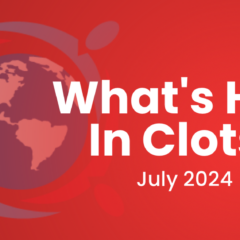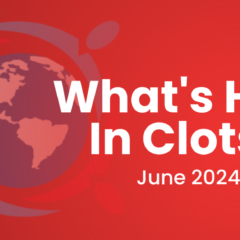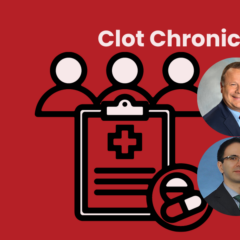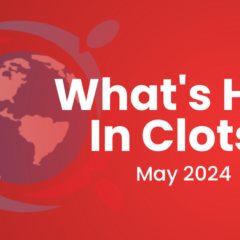Last updated on
Clot Chronicles: Cancer-Associated Thrombosis — Guideline Update
Hello, I’m Dr. Michael Streiff. I’m a Professor of Medicine in the Division of Hematology at Johns Hopkins, and I appreciate the invitation by the North American Thrombosis Forum to present today’s Clot Chronicles on cancer-associated thrombosis guidelines. This Clot Chronicles is based on a meeting we had last year, in May of 2020. It was sponsored by the North American Thrombosis Forum, and the host was Jean Connors of Harvard University and the Dana-Farber.
Our guideline committee was tasked with looking at the most recent versions of cancer-associated thrombosis guidelines. On the committee, in addition to myself, was Syed Abutalib from the Cancer Centers of America in Chicago, Dominique Farge from the University of Paris and McGill University, Martina Murphy from the University of Florida, and Greg Piazza from Harvard University.
The guidelines we looked at, which unfortunately do not include the most recent ASH guidelines because they weren’t out at the time, include the American Society of Clinical Oncology (ASCO) guidelines that were out in that early 2020, the International Society of Thrombosis and Haemostasis (ISTH) guidelines, the International Initiative on Thrombosis and Cancer (ITAC) guidelines, the National Comprehensive Cancer Network (NCCN) guidelines, and the Spanish Society of Medical Oncology (SEOM) guidelines, which had come out earlier in 2020. The topics we focused on were prevention of venous thromboembolism (VTE) in the hospitalized medical oncology patient, the prevention of thrombosis in ambulatory medical patients, prevention of thrombosis in surgical oncology patients, treatment for cancer-associated thrombosis, and then treatment of thrombosis in special patient populations, as well as special types of cancer-associated thrombosis.
On the topic of prevention and medical oncology patients, all the guidelines, obviously, had sections that focused on this topic. All of them recommended some form of pharmacologic prophylaxis. There were some slight or subtle differences between the guidelines. The NCCN guidelines recommend consideration of thromboprophylaxis in all hospitalized medical oncology patients, whereas I think ASCO tended to focus on patients that were not there for stem cell transplant; they recommended against prophylaxis in that patient population. The ITAC and Spanish Society guidelines tended to focus prophylaxis more in patients that had another risk factor in addition to cancer.
In regards to ambulatory patient populations, since the publication of the AVERT and CASSINI trials, direct oral anticoagulants (DOACs) played a prominent role, and all the guidelines recommended that thromboprophylaxis be considered in patients that are intermediate-to-high risk for thrombosis while starting a new form of systemic therapy. So, that would be a Khorana score of 2 or more. The Spanish guidelines, as well as ITAC guidelines, also recommended that one could use other risk scores for identifying patients at risk. The ITAC guidelines also recommended using low-molecular-weight heparin (LMWH) in patients with advanced pancreatic cancer as well.
Multiple myeloma patients are also known to be at high risk for thrombosis, and all the guidelines focus on this population as well. They tend to recommend warfarin or LMWH in high-risk patients and aspirin in low-risk patients. The NCCN guidelines recommend that risk stratification be done using either the IMPEDE VTE score or the SAVED score, which are two evidence-based risk stratification tools for use in multiple myeloma patients to make these decisions, with high-risk patients getting anticoagulant prophylaxis and low-risk patients getting aspirin.
In regards to surgical patient populations, all the guidelines routinely recommend thromboprophylaxis for at least 7 to 10 days after surgery. And also, all the guidelines recommend extended prophylaxis in high-risk abdominal cancer patients for up to 4 weeks after the surgical procedure. In regard to treatment, the treatment space has undergone considerable evolution since the publication of the DOAC trials, which include the HOKUSAI VTE Cancer trial, the SELECT-D trial, the ADAM, and most recently, the Caravaggio study. And all these studies have shown that DOACs are at least as effective as LMWH in the treatment of cancer-associated thrombosis.
As such, DOACs now are found among the treatment recommendations for cancer patients who suffer a cancer-associated thrombosis. All the guidelines generally tend to recommend DOACs in patients who are at lower risk for bleeding—that is patients without gastric or gastroesophageal or in some cases genitourinary lesions, which place patients on DOACs at a little bit higher risk of bleeding—and recommend LMWH for the high bleeding risk populations.
As far as the duration of treatment, all the guidelines generally recommend at least 3 to 6 months of treatments and then, at that point, reconsideration of whether the risk of thrombosis favors continued treatment or if treatment should be discontinued because cancer is in remission or cancer therapy is no longer ongoing.
In regard to special patient populations, thrombocytopenia is treated by most of the guidelines in that they all recommend that patients with platelet counts as low as 50,000 or more should receive treatment doses of anticoagulation for prevention of recurrent thromboembolism in a patient that’s already had a thrombotic event. The NCCN guideline recommends that in patients with platelet counts between 25,000 and 49,000, one could consider using lower dose LMWH regimens instead of using platelet transfusions to keep platelet counts above 50,000.
All the guidelines recommend against use of DOACs or fondaparinux in patients who have platelet counts less than 50,000. Another special patient population at high risk for having bleeding complications with anticoagulants is patients with brain tumors, a group also tackled by most of the guidelines. The ASCO guideline recommends that patients with brain tumors do receive anticoagulation if they suffer a thrombotic event, as does the ITAC guidelines. The SEOM recommends that brain tumor patients be managed similarly to patients that do not have brain tumors and receive anticoagulants. They do recommend, however, that providers consider a 25 to 50% dose reduction of LMWH in high-risk patients with metastatic renal cell or melanoma or brainstem glioma as their tumor.
In patients that have unusual sites of thrombosis, several of the guidelines focus on these as well. All of the guidelines focus on central venous catheter thrombosis and recommend primary treatment for patients that develop a deep vein thrombosis in association with a central venous catheter. ITAC and the NCCN recommend against prophylaxis for catheters without an associated thrombosis. Superficial vein thrombosis is an area of interest in the NCCN guidelines, and they make recommendations regarding anticoagulant treatment for patients that have a superficial vein thrombosis. And then finally, (8:53) vein thrombosis is also treated in the NCCN guidelines where they make recommendations for primary anticoagulant use in patients that have acute splenic vein thrombosis and consideration of other non-anticoagulant treatment in patients that have more chronic splenic vein thrombosis. And obviously, treatment of patients with a splenic vein thrombosis must weigh the risk and benefits of bleeding as these patients can have portal hypertension and gastric and esophageal varices that would increase the bleeding risk in patients who happen to go on anticoagulation.
Finally, our panel highlighted a number of areas where we need more information where guidelines do not provide evidence – and that would be areas such as treatment of arterial thromboembolism in patients with cancer, and treatment of renal vein thrombosis and cerebrovenous sinus thrombosis. And so, those are areas where we encourage new versions of the guidelines to focus on those thrombotic events – and providers need recommendations and guidance on how to treat patients with cancer that have those clots.
Thank you very much for your kind attention. Take care.



